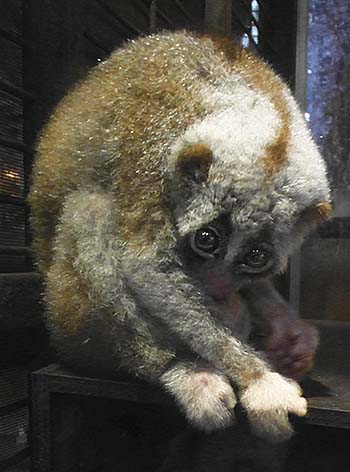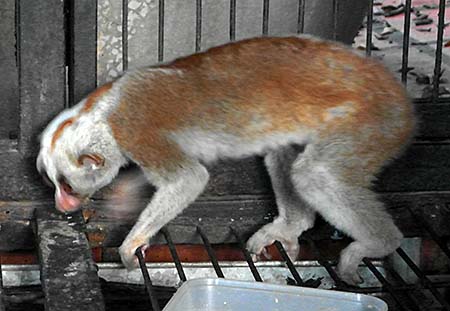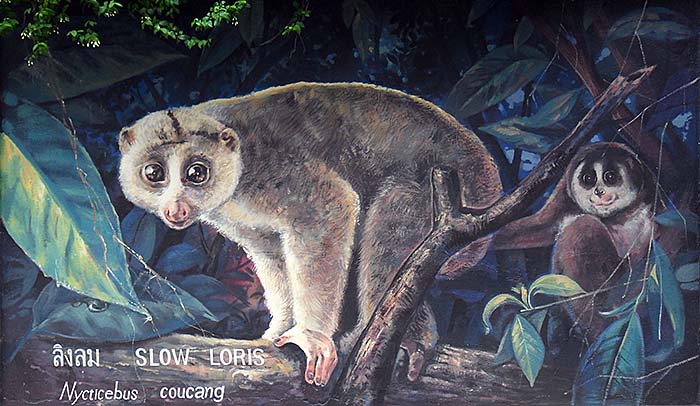1.
Slow Lorises
Slow lorises are a group of small mammals who once lived all over Southeast Asia northwest of the Wallace Line, until deep into south China and east India. There are eight different kinds of them. They are among the few mammals who are poisonous.

A slow loris in 'Snake House', Sihanoukville, Cambodia. Image by Asienreisender, 4/2014
The poison is produced by a gland on their arm, which they lick and activate the toxin due to the blend with saliva. Mothers protect their cubs by spreading the toxin over their fur with the tongue. Adults do the same with themselves, what protects them from parasites like lice, mites etc. Being bitten by a slow loris causes a great pain for a longer timespan, often over days, and it needs sometimes weeks to completely heal out. When biting, the slow loris does not easily let go again. A research on the toxin of slow lorises is done in the BBC Documentary 'Jungle Gremlins of Java'.
Slow lorises look somewhat plump and reach a length between 18cm to 38cm by a weight of 0.3kg to 2kg. They have no tails.
They move or, rather sneak very slowly and spend most of their times in trees. Excellent climbers, their hands are designed to hold a strong grip around branches.
As a nocturnal species, lorises sleep in daytime on branches in the trees. After dusk they start leaving their hideouts and go hunting. Their slow movements make them comming close to potential prey; at the last moment they attack then suddenly very quick. Their diet consists mainly of fruits and insects. Additionally, they feed from small vertebrates, birds, reptiles, eggs and certain plants.
Male lorises are territorial and defend their claim against other male lorises. They live either solitary or in small family groups. A kind of communication for them is to urinate on their hands which makes them leaving a scent track, recognizable for other lorises. Slow lorises are uttering a number of different sounds for accustic communication.

Another slow loris in 'Snake House', Sihanoukville. There were about eight of them there when I visited the place. Image by Asienreisender, 4/2014
Pregnancy lasts slightly over six months, until a female gives birth to usually a single cub, exceptionally twins. Fertility is reached after 18 to 24 months. These nice animals can reach an age of up to 25 years in captivity.
Their poison protects them very well from enemies, apart from the biggest, what is homo sapiens. Widespread superstition makes many people believe that slow lorises have certain powers when parts of their body are applied. It's therefore used as traditional (bad) medicine. In the areas of Pursat and Koh Kong in Cambodia for example, people used the gall of slow lorises to produce an ink for tatoos. Hunting for medical reasons and for pet trade are seriously endangering the species. After caught, their poisonous corner teeth are usually clipped or pulled out, what means great pain and harm to the animals. Following inflammations often lead to the death of the animal. Many die in captivity due to mistreatment and malnurishment. They are not easy to keep and make in fact rather poor pets. Consumerist middle-class women like to 'have' a small loris as a pet, because they find them 'oh, soo cute'. When they soon later realize that the nice animals produce a bad smell, they are often disappointed, to the very disadvantage of the poor victims.
Since the lorises natural habitat is the tropical rainforest, the rapid loss of the forests does great harm to the populations. All lorises are classified as 'vulnerable' or 'endangered' by the IUCN. They are difficult to keep in captivity and particularly to have them breed in captivity. Slow lorises are another of the many species who are going to extinct.

Painting on the outer walls of Dusit Zoo, Bangkok. Image by Asienreisender, 5/2012
Sources
This article is based on a websearch and the good old fellows 'Mammals in Thailand' and 'Grzimek's Animal Life Encyclopedia - Volume 14 - Mammals 3'. The idea to write an article on the small animals came up years ago after a talk with a fellow traveller who found a slow loris on the Bolaven Plateau in Laos. However, I myself was in hope to see one by myself, but over the years I never did with the only exception of 'Snake House' in Sihanoukville, Cambodia.